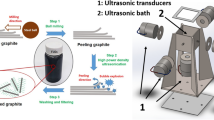Abstract
Paper presents the results of experimental studies aimed to multilayer graphene obtaining. Thermoexpanded graphite was used as a raw material. The technological regulations consisted of two main stages: obtaining a water-graphite suspension by cavitation method and grinding graphite globules on graphene plates using ultrasound or electrohydraulic impact according to Yutkin's method. As a result of the experiment, a few layers of graphene were obtained, which is a pack of 10–20 graphene plates in each. CFD modeling of the cavitation process was performed. The analysis showed that the chosen geometry of the impeller blades, its speed, angle of attack provides the necessary effect—cavitation and the necessary mixing throughout the volume.





























Similar content being viewed by others
References
Birkhoff G, Zarantonello EH (1957) Jets, wakes, and cavities. Acad NewYork. https://doi.org/10.1017/S0022112058210100
Boehm H, Setton R, Stumpp E (1994) Nomenclature and terminology of graphite intercalation compounds (IUPAC recommendations 1994). Pure Appl Chem 66(9):1893–1901. https://doi.org/10.1351/pac199466091893
Geim A, Novoselov K (2007) The rise of grapheme. Nat Mater 6(3):183–191. https://doi.org/10.1038/nmat1849
Jang B, Zhamu A (2008) Processing of nanographene platelets (NGPs) and NGP nanocomposites: a review. J Mater Sci 43(15):5092–5101. https://doi.org/10.1007/s10853-008-2755-2
Kucinskis G, Bajars G, Kleperis J (2013) Graphene in lithium ion battery cathode materials: a review. J Power Sources 240:66–79. https://doi.org/10.1016/j.jpowsour.2013.03.160
Loh K, Bao Q, Ang P, Yang J (2010) The chemistry of graphene. J Mater Chem 20(12):2277–2289. https://doi.org/10.1039/b920539j
Murugan A, Muraliganth T, Manthiram A (2009) Rapid, facile microwave-solvothermal synthesis of graphene nanosheets and their polyaniline nanocomposites for energy strorage. Chem Mater 21(21):5004–5006. https://doi.org/10.1021/cm902413c
Rao C, Sood A, Subrahmanyam K, Govindaraj A (2009) Graphene: the new two-dimensional nanomaterial. Angew Chem Int Ed Engl 48(42):7752–7777. https://doi.org/10.1002/anie.200901678
Rao C, Sood A, Voggu R, Subrahmanyam K (2010) Some novel attributes of graphene. Chem Lett 1:572. https://doi.org/10.1021/jz9004174
Soldano C, Mahmood A, Dujardin E (2010) Production, properties and potential of graphene. Carbon 48:2127. https://doi.org/10.1016/j.carbon.2010.01.058
Stoller M, Park S, Zhu Y, An J, Ruoff R (2008) Graphene-based ultracapacitors. Nano Lett 8:3498–3502. https://doi.org/10.1021/nl802558y
Strativnov E, Bondarenko B, Dmitriev V, Kozhan A, Khovavko A (2021) Method of graphene producing. Patent 149271 Ukr., C01B32/182 (Ukr.)
Strativnov E, Kozhan A, Bondarenko B (2011) Method of obtaining thermally expanded graphite. Patent. 99875 Ukr., C01B 31/04 (Ukr.)
Svishchev G (1994) Venturi tube. Aviation: Encyclopedia. M.: Great Russian Encyclopedia. (Rus.)
Yutkin L (1986) Electrohydraulic effect and its application in industry. Mashinostroenie, Leningrad
Zhi L, Mullen K (2008) A bottom-up approach from molecular nanographenes to unconventional carbon materials. J Mater Chem 18:1472. https://doi.org/10.1039/B717585J
Acknowledgements
Some results of this study were obtained under the support of the National Academy of Sciences of Ukraine (Fundamental research program of NASU “Fundamental problems of nanostructured systems, nanomaterials, nanotechnology”). Research was financed by budget program 6541230 of the National Academy of Sciences of Ukraine “Supporting the development of priority areas of research”. Also this research was supported by funding from a Nation China Natural Science, No. 81660508 and grants from the Guangxi Science and Technology Plan Project, Guike AB16380153, Guike AB17195076.
Author information
Authors and Affiliations
Contributions
SE and KA developed the basics of a two-stage method to obtain a few layers graphene, data processing, and preparation and approval of the final manuscript. GN contributed to the statement of the problem and the way to solve it. SE made CFD modeling. All authors read and approved the final manuscript.
Corresponding author
Ethics declarations
Conflict of interests
The authors declare that they have no competing interests
Additional information
Publisher's Note
Springer Nature remains neutral with regard to jurisdictional claims in published maps and institutional affiliations.
Rights and permissions
Springer Nature or its licensor holds exclusive rights to this article under a publishing agreement with the author(s) or other rightsholder(s); author self-archiving of the accepted manuscript version of this article is solely governed by the terms of such publishing agreement and applicable law.
About this article
Cite this article
Strativnov, E., Khovavko, A. & Guachao, N. Obtaining of globular graphene based on thermally expanded graphite. Appl Nanosci 12, 2791–2811 (2022). https://doi.org/10.1007/s13204-022-02589-1
Received:
Accepted:
Published:
Issue Date:
DOI: https://doi.org/10.1007/s13204-022-02589-1




